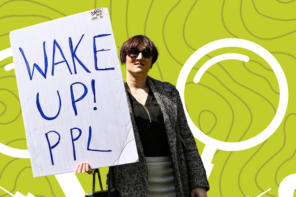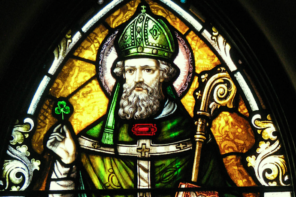Over the last year, I’ve scrolled past social media posts by members of diverse religious backgrounds and political opinions. However, because my ethnographic research is based in Mormon fundamentalist communities, a good amount of the commentary I see leans libertarian or conservative and comes from communities that developed at a time of perceived religious and cultural uncertainty. These new Mormon religious communities—new religions really—bring together shifting religious landscapes and anxieties about everyday life in ways that seldom make sense to the casual observer.
As the world watched a viral pandemic take millions of lives and struggle to develop medical interventions and preventative measures, much of my Facebook feed took on an air of conspiracy. Specifically, QAnon emerged as an answer to an increasingly chaotic world.
QAnon is a conspiracy theory that, frankly, reads like word salad. For supporters, however, it’s a puzzle of cryptic codes and symbols that unveil a Satanic pedophile ring controlling the government. Beginning in 2018, the mysterious figure “Q” began detailing Donald Trump’s ascent to power and the “storm” that was coming to finally end control of the “Deep State” and corrupt government. Using “Q drops,” the cryptic 8Kun messages used to rally supporters, “Q” offered supposed intel to the general population on everything from military psyops to Marina Abramović’s controversial Spirit Cooking art installation.
By the time the January 6 insurrection flashed across my television screen, I’d seen countless Q drops with catchy one-liners to explain their importance. However, as time passed, the content of the conspiracies became increasingly religious (with strong antisemitic undertones) and moved beyond the standard theories espoused by Q supporters.
“Q said it would happen. Special investigation, everything will come out.”
“Noah was a conspiracy theorist, then it started to rain.”
“Don’t get this [Covid] shot if you haven’t already it’s deadly. And why would God and his Prophet [Russell] Nelson [president of the LDS Church] do this to people? People in here actually think this is from God.”
“We have all been warned about the Globalist/Elites plans for the world. Now they are coming in full force. Even our own LDS leaders are calling themselves Global Citizens.”
“I believe that Brigham Young was a Rothschilds agent sent to assassinate the Smith family and gain control over the church. The Cabal have taken over every major religious institutions. The Book of Mormon warns against this, but modern day propehts [sic] don’t even talk about it, and also.cover up a lot of what Joseph Smith taught.”
Wait, what?
That last one is what initially piqued my interest in a new Mormon religion that took QAnon’s theories and canonized them as doctrine.
Scholars of religion took Q by storm (pun intended). Many framed it within the context of white evangelicalism. Others rightfully highlighted the New Age characteristics that many supporters espoused, specifically in terms of vaccine hesitancy. Underlying most perspectives was the prevailing assumption that Q is not a religion, but the product of American religion’s entanglement with conservative politics.
Earlier this year, PRRI offered statistics for the intersection of Q-belief and religion, noting that white evangelicals, Hispanic evangelicals, and Mormons are most likely to believe the ideas espoused by Q. This includes 21% of Mormons who believe in QAnon, and 18% who specifically believe that “the government, media, and financial worlds in the U.S. are controlled by a group of Satan-worshipping pedophiles who run a global child sex trafficking operation.”
Things grew complicated in 2021 as the vaccine became widely available. The leadership of the Church of Jesus Christ of Latter-day Saints, the largest branch of Mormonism, acted quickly during the pandemic to close temples and offer guidelines for Church meetings, including social distancing and masks. In addition, they encouraged vaccines, referring to the medical technology as a “literal godsend.” On January 19, 2021, the President of the Church and other senior members of leadership received their own vaccination, sparking both applause and outrage.
Members with political disagreements felt ostracized, and some began questioning their membership in the LDS Church altogether. Others took these events as confirmation that the hierarchy of the Church had gone astray.
Reenchanting the world
The LDS Church’s central claim of Restoration necessitates something lost and restored. Since the 1830 founding of the religion, schism has remained the rule, with many factions of the movement claiming apostasy among the leaders of the dominant faith. One such example emerged in 2013 with a man named Denver Snuffer, leader of the Remnant movement.
Snuffer became well-known in Mormon circles for his widely read publications that outlined the path for individuals to encounter Jesus Christ and have assurance of their salvation without the need for a religious institution. Ultimately, Snuffer claimed that God had “terminated the priesthood authority” of the LDS Church, leading it into apostasy. In response, he was excommunicated in 2013. Since then Snuffer has canonized new scriptures, raised funds to build a temple, and held conferences for national audiences.
Snuffer’s claims became controversial in historical circles in 2017 when he began preaching that Joseph Smith, the founder of Mormonism, did not practice polygamy; that he was, in fact, an ardent opponent of the practice. According to Snuffer, the LDS Church began a long downward spiral following the death of Smith. After his death, Brigham Young rose to power and used Joseph Smith’s history to justify the formation of the controversial marital practice.
During the 2016 Sunstone Symposium, I watched Snuffer present “Was There an Original” to a standing-room-only audience at the University of Utah. He was charismatic and spoke of an authentic Mormonism that was lost after the death of Joseph Smith. This loss only escalated and amounted to the current state of apostasy in the LDS Church. The goal of his movement, the Remnant, is to recapture an “authentic” Mormonism marked by spiritual experience and individual encounter with God that doesn’t necessitate a temporal intermediary—which is to say a priesthood or any individual with a special relationship to God.
Already in 2016, Snuffer’s historical narrative spoke the language of conspiracy. In addition to his claim of an authentic Mormonism is a claim about the transformation of Mormonism under Brigham Young into a polygamous and theocratic institution that was unknown to Smith. The claim led his followers to polygamy denial, a hallmark of the movement that requires extraordinary reimagining of historical evidence for the practice. Snuffer afforded Mormons a method for reenchanting the world, and a way to make sense of a chaotic history that brings their leaders into question.
Snuffer’s movement is distinctly religious, with few political claims. However, in the wake of the global pandemic, some sought answers that moved beyond the spiritual realm. Enter Phil Davis, a member of the LDS Church known for the artisan chocolate shop that he co-owned with Morgan Coleman in downtown Provo, UT. As of 2020, Davis is the head chocolatier at Small Batch Cacao.
While most know him for his chocolates, some also know him as the End Times Servant who was called to gather the elect and prepare for the return of Jesus Christ. His movement, Doctrine of Christ, isn’t large, but constitutes one of the latest expressions of Mormonism that speaks to the context that we find ourselves in. According to Davis, an angel visited him in his chocolate shop, followed by a translated being who authorized him into a new Terrestrial Order of the Church.
Doctrine of Christ takes the Snuffer claim a step further, arguing that Brigham Young had the priesthood revoked in the 1830s. After supposedly murdering Joseph Smith, Young claimed ownership of the Church and led it down the path to ruin. However, in recent times, Joseph Smith returned to inaugurate a re-restoration at the hand of the Davidic Servant, Phil Davis.
Earlier this year, the movement linked the perceived apostasy of the LDS Church to the political claims that circulated in conspiracy circles, beginning with the Church’s endorsement of “globalist agendas” and promotion of the “secret combinations” that control the Covid-19 narrative. Under an image of Russell M. Nelson, the group wrote:
“Our research demonstrates that this tyrant is using a false pandemic to force the world to accept a vaccination. This ‘cure’ will make most people who receive it susceptible to a ‘wild virus.’ This may surface later on, after most of the entire human population’s immune systems weaken due to the vaccine.”
According to Doctrine of Christ supporters, the virus and subsequent vaccine is part of the “Arch Tyrant” plan to depopulate 90% of the earth. One article pointed to the United Nations as central to this mission, with others citing the Illuminati, Masons, Jesuits, and other entities historically linked to end times apocalypticism. The conspiracies that found their place in American homes and internet forums became doctrine.
Currently, Doctrine of Christ has 367 YouTube subscribers and 231 followers on social media. The movement is small, but its existence makes sense within the context of new Mormon groups that emerged within the last decade, and it’s likely to continue growing. Davis and his community harnessed a desire for enchantment that many no longer find in the LDS Church, and the conspiracies provide a comforting response to a chaotic world. In a time of heightened skepticism toward various establishments, he spoke to a craving for independence, both politically and religiously.
When I first posted about this new group on social media, it was met with interest and several people expressing that the Brigham Young conspiracy would make a great movie. Well, they’re in luck. Phil Davis and the Doctrine of Christ anticipate a movie premier, The Return of Joseph Smith, on April 15 at Thanksgiving Point in Lehi, UT. The movie offers an alternate history to the LDS succession era, and answers people’s deepest questions as they seek meaning in an uncertain world.





